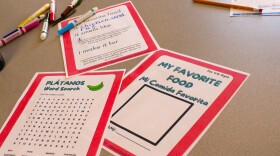Federal immigration authorities in recent months have begun installing 911 distress signs with location codes along remote stretches of the U.S border in New Hampshire, Vermont and New York in an effort to assist migrants who may become stranded in perilous conditions as they seek to enter the country from Canada.
The system of coded signs, already widely used along the country’s southern border with Mexico, is a reflection of the dangers migrants face when attempting to cross in harsh, wintry conditions. It’s also evidence of the rise in crossings in the region that has led to rescues by Canadian and U.S. border agents.
Along the 295-mile border patrolled by the U.S. Customs and Border Protection's Swanton Sector, more than 3,100 people were apprehended between October and February, more than the previous four fiscal years combined. Nearly all of those encounters occurred in New York and Vermont.
As the number of encounters have gone up, there has also been a reported increase in both rescues and recoveries, according to border officials, often in challenging weather conditions.
“The environment, the remoteness & unpredictable weather along the Canadian border in northern NY, VT & NH is unforgiving,” Swanton Sector Chief Patrol Agent Robert Garcia recently said on social media. “Don’t Risk It!”
The recently installed signs carry simple instructions to call 911, with a number corresponding to a specific GPS location where responders will be dispatched to, according to a spokesperson for Border Patrol.
The signs are part of the Missing Migrant Program, which immigration authorities launched in 2017 along the southern border to assist migrants who get stranded in remote, desert conditions. More than 2,700 signs with individual location information were in place along the U.S.-Mexico border, as of 2022.
This is the first expansion of the program anywhere along the nation’s northern border with Canada, the agency confirmed.
Border officials declined to say how many signs have been installed in New Hampshire, Vermont and New York, or provide their approximate locations. The signs were erected in October, although local 911 dispatchers in New Hampshire were not notified about the program until January, a lapse in communication that rendered the signs’ location codes meaningless for months.
“When we learned about the signs, [Division of Emergency Services and Communications] Director Mark Doyle reached out to U.S. Customs and Border Protection and explained that we answer all 911 calls for the state and transfer calls to local dispatch centers,” said a spokesperson for New Hampshire’s Department of Safety. “Since that initial conversation, the location codes that are displayed on the signs along the border have been built into DESC’s mapping software so we know exactly where a caller is should they need help.”
Crossings have resulted in tragedies in recent years, including last January, when a Haitian man was found dead from hypothermia in a remote stretch of Quebec near the international border with Champlain, New York. The Associated Press also reported that in 2019, a Dominican man died in the same region.
In March 2023, eight migrants seeking to enter the U.S. from Canada drowned while trying to cross the St. Lawrence River in the Mohawk community of Akwesasne, the Montreal Gazette reported.
“We've had to mount rescue operations for people who got lost and disoriented,” Sgt. Charles Poirer with the Royal Canadian Mounted Police previously told NHPR. “And it actually put some of our officers in danger themselves. We had a few officers that had to go to the hospital because of hypothermia and frostbite.”
Though there has been a documented increase in migrant encounters in New York and Vermont, there have been only a scant number of interactions with migrants who were confirmed to have crossed the New Hampshire-Canada border. Just 21 interactions were logged by Border Patrol agents in the state during a 15-month period ending in Dec. 2023, according to recently released data.
New Hampshire’s approximately 58-mile border with Canada includes relatively few road crossings and is sparsely populated. Aurora Sustainable Lands, a private company that owns the majority of land in New Hampshire bordering Canada, did not respond to requests for comment on whether it granted permission to Border Patrol to erect signs on its property.
At least one sign located in New Hampshire contains the word “help” in both English and French, along with instructions to call 911 and a six-digit location code.
“Signage language reflects the most encountered nationality/language within that specific area,” Border Patrol officials said when asked about the choice of languages.
New Hampshire officials declined to say if the newly installed signs have assisted in any rescues, to date.





